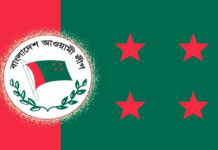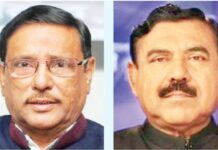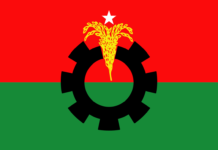Politics loses its Ershad factor

With the death of General Ershad, a prominent factor in Bangladesh politics has come to a close. From a soldier to a military dictator and then to a political leader, Ershad would surely be regarded by many as lucky. The man, who was supposed to be in prison until death, will now be laid to rest with the honour of the leader of the opposition in parliament and former special envoy to the PM. Not only that. Many of those who had once been his arch enemies are now grieving his passing.
So how did the “Ershad factor” come about?
To understand Ershad, his life has to be divided into three phases. First, his life in military service—from the Liberation War to 1982. Second, his stay in state power from 1982 to 1990 and third, from 1991 to his death.
That Ershad was opportunistic and power-hungry was clear since long before he entered politics. His role during the Liberation War is quite telling. As a senior officer with the rank of a Lt Colonel, he squandered the opportunity to join the war and chose to go to Pakistan instead. He did so when his colleagues, including Major General Abdul Monjur,fled to Bangladesh risking their lives to join the war. A trial is now underway over the allegation that Monjur was later killed on Ershad’s instructions.
Ershad enjoyed the favour of Bangabandhu, Mushtaq and Zia governments. Bangabandhu’s government sent him to India for training in June 1975. At that time, he was an official of colonel rank, but the training was meant for the officials of Brigadier rank. The then government promoted him accordingly so that he could take part in the training. He showed his true colours after the August 15 tragedy when he visited Bangladesh just to meet Bangabandhu’s killers at the Bangabhaban. At the time, he had been attending a national defence course at the Agra Cantonment in India.
On August 24, within two weeks of Bangabandhu being killed, he was promoted to major general and made the deputy chief of army while he was still in training in India. His lucky streak was evident: becoming a major general and deputy army chief from a colonel in a span of only three months.
Another military ruler, General Zia, made Ershad the military chief. He thought Ershad, who was known to be a philanderer, would be more interested in other pursuits rather than enter the theatre of politics. Zia picked Ershad over other generals thinking that Ershad would pose no threat to his ambition. But Ershad was lying in wait. Ershad, who returned from Pakistan in 1973, sought to drive a wedge between the army officers who took part in the Liberation War and those who returned from Pakistan.
In 1981, when General Zia was murdered at the height of that division, Chattogram’s GOC General Manzur was killed allegedly upon Ershad’s instructions. The trial of the case has been ongoing since 1995. The court ordered reinvestigation of the case just a day before the verdict was to be delivered. Here too, Ershad, who was the number one accused in the case, was lucky.
Ershad began working his way to state power soon after Zia’s murder. He appeared hell-bent on proving that Justice Abdus Sattar, who became the president after Zia’s death, was a failure. At one point, he demanded that the army be given a share of state power and that it should be included in the constitution. In November 1981, then army chief Ershad called a number of newspaper editors and handed them a list of his demands, breaching all protocols. He told them that the army should have a constitutional right to hold state power. He couldn’t wait any longer and seized state power by issuing a military decree on March 24, 1982, and ousted an elected government without bloodshed.
Immediately afterwards, he launched a campaign of repression to consolidate his power. Later, he himself formed a political party, following the footsteps of his predecessor. Like Zia, Ershad too bought politicians from different parties and gathered them in his party. He had by his side politicians of every hue. Those from the BNP constituted the mainstay of his party.
Ershad came to be known as a ruthless dictator during his tenure from 1982 to 1990. He took harsh measures to repress the simultaneous movements waged by the Awami League, the BNP and the left-leaning political parties. He resorted to bullets to quell the movement initiated by the students in mid-February of 1983. His campaign of repression had soon escalated into a campaign of murders in cold blood. And at this point in time, state-sponsored corruption gained a firm foothold. The concept that one can get away with corruption began to take shape during Ershad’s regime.
Ershad set an ultimate example of using religion as a tool to cling to power. The vibrant presence of religious fundamentalism that we see in politics today was started by Zia and carried forward more deftly by Ershad.
Not only did he make Islam the “state religion” but also instigated communal conflict—in order to stay in power. In his personal life, he was far from being religious but he never shied away when it came to using religion for political gain.
Though hundreds of Nur Hossains and Dr Milons shed blood to see him ousted, Ershad managed to cling to power for nine years.
But nothing could save him eventually. Even his closest ally, the army, turned its back on him at one point. In December 1990, Ershad, once depicted as bishwa behaya by artist Kamrul Hasan in an artwork, had to resign in the face of a mass uprising.
With his ouster, the possibility of ushering in a liberal, non-communal nation was rekindled. Thethree-party alliancedid prepare a design but that too was hit hard with Khaleda Zia soaring to power while holding the hand of Jamaat in the fifth parliamentary election in 1991. Ershad was slapped with a few dozens of cases. He faced trial and sentences. He was behind bars throughout that five-year rule of Khaleda Zia. Despite being in jail, he won in five constituencies in the 1991 national election and his party secured 35 seats in parliament. Thus, the tyrant who was ousted through a mass upsurge found his way back into politics.
He won in five constituencies in the election of 1996 and his party won 33 seats. He managed a cabinet berth for his party’s secretary general by lending support to Awami League, although the BNP envoys had met him in jail and requested him not to do so. Some of his party leaders also met him inside jail, but Ershad, having spent six years behind bars and resentful of the BNP, would not budge. Six months into the formation of Awami League government, he walked out of jail and two years later, he lent his support to Khaleda Zia and joined her four-party alliance. This made him a member of the opposition outside parliament but pro-government inside parliament. This situation led to a split in his party, which in the past as well had cracked due to Ershad’s relations with a woman.
Before the 2001 election, the Jatiya Party split into three parts due to Ershad’s confusion over which party to align with. Ershad was sentenced by the trial court in a graft case during the regime of Khaleda Zia. But in that case, the final judgement came from the Appellate Division during the regime of Awami League. He lost his position as a member of the parliament and was declared unqualified to contest elections. Once again, he was jailed. He was released after paying fines to the state exchequer. Khaleda Zia, who had kept Ershad in jail for six years, who gained the reputation of an uncompromising leader for participating in the anti-autocracy movement, and who had accused Ershad of murdering her husband, went to Ershad’s place to show sympathy the very night he was released from jail. Once again luck was on his side because BNP soared to power through the eighth general election in 2001 and Ershad’s party got 14 seats.
He joined the Awami League-led grand alliance right before the ninth general election, got 27 seats. After changing decisions multiple times in dramatic manner, he contested the 10th general election despite resistance from his wife Rowshan Ershad. The Awami League needed Jatiya Party by its side to hold the election which was boycotted by the BNP. Ershad ended up as a subordinate to his wife, the opposition leader in parliament. He contested the latest election from the grand alliance as well and got elected as the opposition leader of the parliament.
This man, who once refused to address Sheikh Mujib as “Bangabandhu” (the Father Of The Nation) while in power, made one of Bangabandhu’s assassins a contestant in the presidential election and gave him the chance to sit in parliament, was lucky enough to become a member of the committee formed to celebrate the 100th birth anniversary of Bangabandhu.
Despite restoration of democracy after the fall of Ershad, the two main political parties, the Awami League and the BNP, prioritised politics of getting to power over that of principle. Thus, Ershad and his party gained legitimacy in politics, kept taking advantage of the conflicts between these two parties. The two parties have used Ershad time and again by intimidating him of jail terms and punishments and this is how Ershad survived.
Because of the politics of getting to power, Ershad could play one party against the other. The question of ideological coherence remained ignored. Those who prosecuted Ershad for murder, jailed him for corruption, pledged to build a democratic social system by removing him, only removed the person Ershad but not his ways. This is why, December 6, the day Ershad was removed from power has been celebrated as the “Democracy Day” in the first few years but no one remembers it anymore.
Zayadul Ahsan Pintu is Editor, DBC News.









